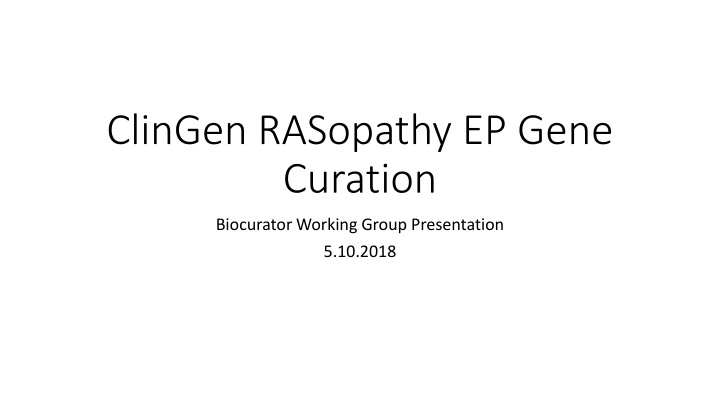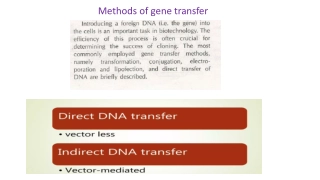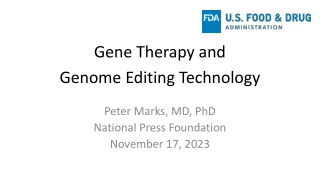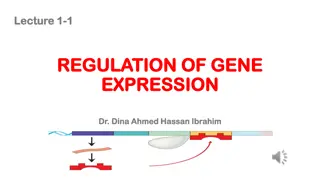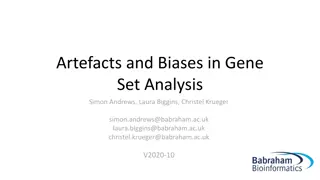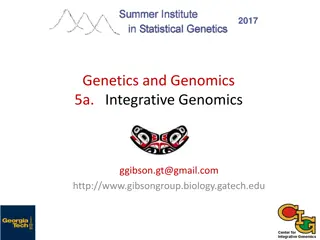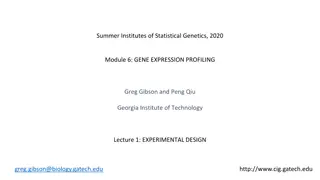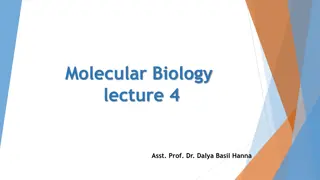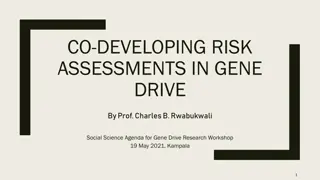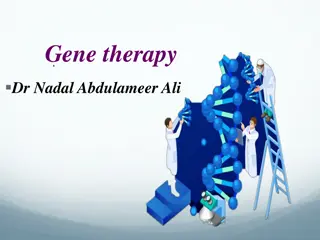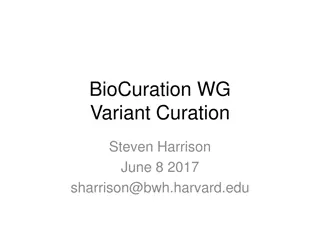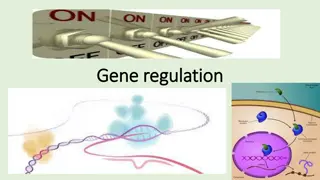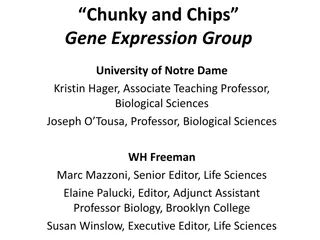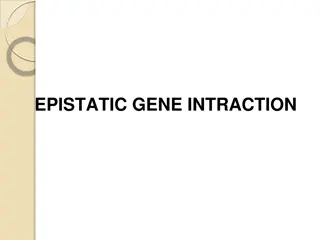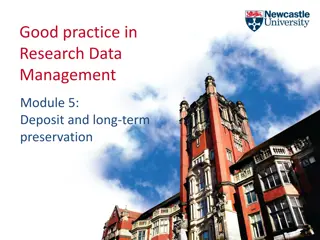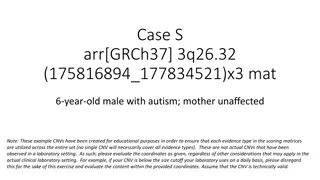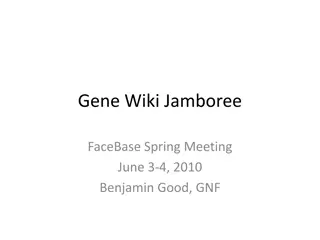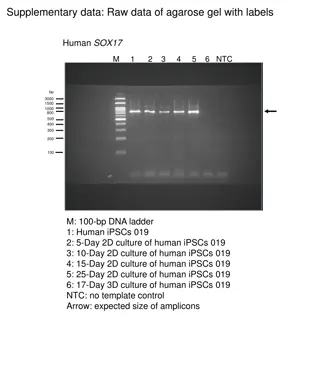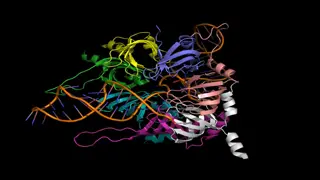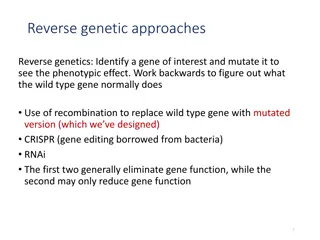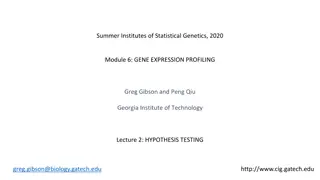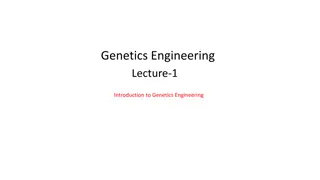ClinGen RASopathy EP Gene Curation
ClinGen RASopathies involve complex diseases associated with the RAS/MAPK pathway, affecting various systems and presenting congenital anomalies. The working group focuses on gene and variant curation, aiming to resolve discrepancies in pathogenicity classification and define gene-disease relationships for RASopathy variants. Assessing gene-disease validity is crucial in understanding these syndromes' underlying mechanisms.
Download Presentation

Please find below an Image/Link to download the presentation.
The content on the website is provided AS IS for your information and personal use only. It may not be sold, licensed, or shared on other websites without obtaining consent from the author.If you encounter any issues during the download, it is possible that the publisher has removed the file from their server.
You are allowed to download the files provided on this website for personal or commercial use, subject to the condition that they are used lawfully. All files are the property of their respective owners.
The content on the website is provided AS IS for your information and personal use only. It may not be sold, licensed, or shared on other websites without obtaining consent from the author.
E N D
Presentation Transcript
ClinGen RASopathy EP Gene Curation Biocurator Working Group Presentation 5.10.2018
ClinGen RASopathy EP Personnel Mitchell Dillon, MS, CGC Katherine Rauen, MD, PhD Lisa Vincent, PhD (Co-chair) H l ne Cav , PharmD, PhD Bruce Gelb, MD (Co-chair) Danielle Azzariti, MS, CGC (Coordinator) Bradley Williams, MS, CGC Brandon Cushman (biocurator) Andrew Grant (biocurator) Martin Zenker, MD Heather Mason-Suares PhD Karen Gripp, MD Jennifer A. Lee, PhD
Goals of the RASopathy EP GENES A2ML1 BRAF HRAS KRAS LZTR1 MAP2K1 MAP2K2 MRAS NRAS PPP1CB PTPN11 RAF1 RASA1 RASA2 RIT1 RRAS SHOC2 SOS1 SOS2 Phenotypes Noonan Syndrome (NS) Cardiofaciocutaneous syndrome (CFC) Costello syndrome (CS) Noonan syndrome with multiple lentigines (NSML) Noonan-like syndrome with loose anagen hair (NS/LAH) 1. Variant Curation Specify rules for the application of ACMG codes for RASopathy variants Resolve discrepancies in ClinVar Provide an expert panel classification for variants in ClinVar 2. Gene Curation Curate evidence for gene-disease relationships using ClinGen s clinical- validity framework Curated evidence for 19 different RASopathy genes associations with 5 different conditions.
Background RASopathies are a complex group of diseases associated with alterations in the RAS/MAPK pathway that lead to multiple congenital anomalies, for example: Craniofacial anomalies Cardiovascular abnormalities Short stature Hematologic/oncologic manifestations Skin and hair anomalies Intellectual deficits Nervous/musculo-skeletal abnormalities Vision impairment Rauen et al. 2013
ClinGen Gene-Disease Validity Classifications Disputed, 2 Limited, 4 Definitive, 10 Moderate, 1 Strong , 2 Definitive Strong Moderate Limited Disputed Highest association with a RASopathy of all 19 genes (unpublished data). http://www.clinicalgenome.org/knowledge-curation/gene-curation/
RASopathy Gene curation Workflow Present survey results Primary Biocuration (Expertise in ClinGen Framework) Expert Review/Discussion (ClinGen RASopathy EP) Survey Group Members Finalize clinical- validity Consensus (80%) reached? No Yes ->
Major Challenges of the GC effort Problem 1: The literature contains many cases that are unclearly phenotyped published cases. For certain curations, phenotypic variability and overlap of individuals with RASopathy disorders is often not detailed enough to differentiate some conditions. Note: The RASopathies are considered and treated by the clinical experts in the field to be distinct conditions.
Major Challenges of the GC effort Problem #2: Most functional evidence measures the same end point and result across clinical phenotypes and therefore do not directly implicate one phenotype vs. another. Examples: Changes in levels of phosphorylation of certain proteins in the pathway RASopathy features in animal models (i.e. short stature, cardiovascular anomalies, and craniofacial anomalies in mice) Biochemical function of being in the RAS pathway which is linked to all these disorders Note: There are exceptions to this i.e. PTPN11:NS/NSML have alleles that cause different changes in phosphorylation and there is an HRAS mouse model with Costello-specific features.
Problem 1-Lump or split? The expert panel is against the replacement of all disease terms by RASopathies, but is there sufficient evidence to split based on L/S guidelines? Assertion for conditions Inheritance pattern Molecular mechanisms Phenotypic variability Gene-Disease Comments More vague phenotypic borders and specific mutations have been recurrently identified in individuals with less severe ID. Age- dependent features inform treatment BRAF- CFC/Noonan Yes No (AD) Not unique - Debatable - Examples Certain PTPN11-NSML variants have displayed clearly different functional properties (reduced phosphatase activity) compared to that of NS, which cause increased phosphatase activity Yes No (AD) PTPN11- Noonan/ NSML Yes Yes Overall conclusion: Though the current debates in the field of nosology question whether we should think about RASopathies as one entity, to maintain the clinical utility of our work we must curate in the context of the current nosology of the disease domain. Split. (RASopathy 2018 conference is slated to discuss the nosology issue in the domain.)
Curation for weak gene-disease claims In order to provide the granularity that we hope will be useful for clinicians, we curated all 19 genes for all 5 of the conditions we chose to assess. In doing so, we came across several associations with weaker claims (categories below) that needed to be addressed.
Disputing weak gene-disease claims Part of splitting out all of the RASopathy associations for each gene was to be able to Dispute claims that the experts felt were misleading in published literature. Example: Several genes have had patients described as more Costello-like, but the field feels very strongly that Costello syndrome is only caused by HRAS How we defined Disputed: any claim* that either did not have enough evidence to support variant pathogenicity, did not provide phenotypic evidence that was convincing enough to count the patient for that disorder, or did not make a strong diagnostic claim. *Note: A claim, or suggested claim had to be present to Dispute, otherwise there was No Evidence.
Disputed disease claim (example) SOS1 and Cardiofaciocutaneous syndrome (3 publications w/cases) Publication Patient Sex Age Variant Diagnosis Comments Score Narumi 2008; 18651097 NS84 Male 8 years p.Pro481_Gly482insArg-Leu-Pro Recruited from CFC cohort No evidence for variant pathogencity. Only HRAS, KRAS, BRAF, MEK1/2 SOS1 seq. 0 pts NS204 Male 1y 4m p.Arg552Ser NS/CFC Examined at 1y 4m with weak claim 0 pts NS211 Male 2y 8m p.Glu846Lys atypical for both NS and for CFC with ID resembling CFC Variant was functionally characterized but the claim is not strong 0 pts Nystrom 2008; 18456719 Patient 3 Female 7.9 years p.Glu433Lys CFC, no ID present Developmental delay/ID is one of the indicators of true CFC and only PTPN11 and SOS1 were seq. 0 pts Turmukhuu 2010; 20030748 Patient 2 Female 2y 1m p.Thr158Ala Inconclusive between CFC and CS This claim was not strong despite them indicating that the patient was leaning more towards CFC w/ ID present 0 pts Note: 3 other studies have been published with variants in SOS1 that cause changes in phosphorylation of the RAS pathway, but these should not be scored as the end points only implicate the variants pathogenicity-not that they only cause CFC. Conclusion: Despite that some claims have been made suggesting that patients with variants in SOS1 may have CFC, there were no scoreable cases present, therefore the RAS EP chose to Dispute the current claims that SOS1 causes CFC.
Example of weak, Limited disease claim NRAS-CFC (1 publication with 2 possible CFC cases) Publication Patient Sex Age Variant(s) Diagnosis Comments Score 0 pts Altmuller 2017 28594414 Patient_7 Femal e 2y 5m NRAS p.Glu37dup And 22q11.23 duplication complex phenotype (hypoxic ischemic encephalopathy) with features of CFC probable modification by the 22q11.23 duplication prevented this case from being scored Patient_11 Female 11 years NRAS p.Thr50Ile Facial features more in line with CFC and mild motor and intellectual delay Though patients with the p.T50I variant have been identified as patients with NS with no or mild developmental problems, this variant is functionally characterized and CFC is suspected at 11 years, so this claim cannot be disputed at this time. 0.5 pts Conclusion: The evidence supporting the association is Limited(0.5) atthis time, but further elucidation of the mechanisms underlying NS and CFC or re-evaluation of this patient may prompt reason to dispute this association
Problem 2-experimental evidence Most of the experimental evidence is not actually specific to a clinical phenotype. Example 1 KRAS-Noonan mouse model Hernandez-Porras et al. 2014 developed a KRAS p.V14I knock-in mouse model Homozygous p.V14I mice showed perinatal lethality but surviving mice showed reduced body size, facial dysmorphisms similar to human NS phenotype , cardiac hyperplasia, valvular hypertrophy, splenomegaly, myeloproliferative disorders. Hernandez-Porras 2014 Figure 1. A. Growth curves of mice show significant short stature in het and hom mice with variant. B. Relative lengths of mice. C. % survival by age D. X-rays demonstrating craniofacial anomalies Het mice were not perinatal lethal but exhibited similar, less severe phenotypes.
Problem 2-experimental evidence (cont.) Most of the experimental evidence is not actually specific to a clinical phenotype. Example 2 KRAS- Noonan/CFC Functional alteration studies Schubbert et al. 2007 (NS)- found that variants seen in NS diagnosed patients caused increased phosphorylation of MEK and ERK in COS-7 cells Sovik et al. 2007 (CFC)- found that a variant seen in a patient diagnosed with CFC also induced increased levels of phosphorylated MEK. Schubbert 2007 Figure 1B. Example of a results showing that various KRAS variants cause GOF of the pathway.
However, in order to maintain consistency with the ClinGen Gene Curation framework, we chose to downgrade functional evidence that provided some support for the gene:disease associations instead of discounting all of it. Our original proposal Provide a score for the gene s association with a RASopathy that does include experimental evidence. -AND- Provide scores for the gene s association with specific phenotypes that do not include experimental data. Example: BRAF: CFC syndrome = Definitive (12) >12 points of de novo/non-de novo occurrences from CFC cases Zebrafish model, mouse model, NIH3T3 or HEK293 signaling assays showing altered SMAD1 and ERK phosphorylation from CFC patient variants. Also changing binding to Ras-GTP rel. to WT (6 pts) BRAF:RASopathy = Definitive (18) >12 points of de novo/non-de novo occurrences from either Noonan or CFC cases Zebrafish model, mouse model, NIH3T3 or HEK293 signaling assays showing altered MEK, SMAD1 and ERK phosphorylation from RASopathy patient variants. Also changing binding to Ras-GTP rel. to WT (6 pts) BRAF: Noonan=Moderate (10) 5 de novo Noonan unscored non-de novo missense (10 pts) 2 functional assays showing variants increased kinase activities of MEK and ERK (1 point)
Scoring of experimental evidence General scores of various experiments Evidence Type Comments Biochemical Function/Protein interaction All genes except LZTR1 achieved 0.5 pts based on the well-established biochemical function and protein interactions of the pathway. Expression Ubiquitous expression of these genes prevented the scoring of tissue-specific expression of the RASopathy genes (0 pts) Functional alteration Assessed stringently for supporting disease causation and were only scored separately when a distinct assay directly supported a unique mechanism or endpoint for the specific condition being assessed (typically 0 pts) Knock-in animal models With the exception of the HRAS-CS mouse displaying the CS-specific enamel phenotype, animal models were downgraded from 2 (default) to 0.5 pts due to their lack of display of differentiating phenotypes of the RASopathy conditions. The animal models were only scored for the syndromes in which the variants had been observed in patients. If the variant had been seen in both it was only scored for the primary gene-disease association
Specific experimental evidence examples Gene- Disease Type Publication Evidence Description Comments Score Decided to use experiments such as this to support non-de novovariant pathogenicty (0.5 pts) instead of scoring the functional evidence as increased ELK or ERK phosphorylation is not specific to CFC Functional alteration Luciferase assay reveals that the p.D153V protein led to significantly higher levels of ELK activation than the WT. KRAS-CFC Niihori 2006 0 pts These phenotypes were present in the RRAS-NS c. elegans model as well (Flex 2014). May normally give 1 point to a worm model but this is extremely non-specific Worms expressing p.Ser2Gly variant (recurring de novo) NS/LAH variant developed protruding vulva, decreased egg laying efficiency. SHOC2- NS/LAH Cordeddu 2009 Animal Model 0.25 pts This study performed in vitro phosphatase assays to determine the effect of the Y279C, T468M, and Q510P variants on protein function. All variants showed abolished phosphatase activity, this is unique to NSML as NS variants are GOF. PTPN11- NSML Functional alteration Hanna 2006 0.5 pts Knock in of p.Q257R (CFC-only variant) caused decreased survivial, growth retardation, spinal abnormalities, sparse and ruffled fur, facial dysmorphism, long and dystrophic nails, pulmonary stenosis, and atrial septal defects. Downgraded to 0.5 pts because there were no features that made this mouse scoreable to only a CFC curation other than the variant. This model was only scored for CFC BRAF-CFC Moriya 2015 Animal Model 0.5 pts
Results of Curation Project Definitive, 12 Disputed, 2 Strong, 4 Moderate, 2 Limited, 4 Definitive, 10 Limited , 13 No evidence, 56 Moderate, 1 Strong , 2 Disputed, 13 Definitive Strong Moderate Limited Disputed Definitive Strong Moderate Limited Disputed No evidence Highest RASopathy Association Achieved for all 19 genes Clinical-validity classifications of all 95 curations
Results of Curation Project NS/LAH, 2 NS/LAH, 2 NSML, 5 NSML, 1 Costello syndrome, 1 Noonan Syndrome, 8 Costello syndrome, 2 Noonan Syndrome, 16 CFC, 4 CFC, 6 Noonan Syndrome CFC Costello syndrome NSML NS/LAH Noonan Syndrome CFC Costello syndrome NSML NS/LAH # of genes strongly/definitively associated with each condition # of genes with scoreable evidence for each condition
Results of Curation Project Presented our results by gene as opposed to by each individual gene:disease Also supplied supplementary evidence tables. Denotes a gene that had internal case data used. Cited a pending ClinVar submission from GeneDx in supplement. - denotes a No Evidence association
Conclusions/future work A total of 95 curations were performed on 19 genes across 5 distinct RASopathy conditions. We hope that in providing the granularity for each condition associated with all the genes, we can inform clinicians interpreting molecular diagnoses which conditions have been implicated with which genes and how strong the evidence linking them is. This work is currently undergoing review to be published in the ClinGen Human Mutation Special Issue Further specifications should be discussed on how experimental evidence is scored for genes with multiple associations The RASopathy GC effort is not over!! Other RASopathy genes (e.g. SPRED1, CBL, NF1, KATB6, NSUN2)
Acknowledgements Thank you to the following groups ClinGen RASopathy Expert panel ClinGen Gene Curation Working Group ClinGen Clinical Domain Oversight Committee ClinGen Lumping and Splitting Working Group Special thanks to Brandon Cushman, Lisa Vincent, Martin Zenker, Marina DiStefano, Heidi Rehm, Johnathan Berg, and Courtney Thaxton for their efforts, feedback and guidance through the curation and writing process.
PTPN11 and Noonan Syndrome Genetic Evidence Tartaglia et al. 2001 2 probands (1 pt) Gulec et al. 2015 1 de novo proband (2 pts) Demir et al. 2010 1 proband (0.5 pts) Christensen et al. 2013 1 de novo proband (2 pts) Atik et al. 2016 1 de novo proband (2 pts) Schollen et al. 2003 1 proband; 10 segregations (5.5 pts) Schollen et al. 2013 7 probands; 10 segregations (>12 pts) Genetic evidence maxed out
PTPN11 and Noonan Syndrome Experimental Evidence Pannone et al. 2017 ERK activation studies on variants in L261, L262, and R265 residues. (0.5 pt) maxes biochem Tartaglia et al. 2006 Phosphatase activity assay of A72S, E76D, N308D, and M504V NS-associated variants. (0 pt) Araki et al. 2004 Knock-in mouse for D61G variant. Mice mirrored phenotype and demonstrated increased pERK in development. (0.5 pts) Oishi et al. 2006 Knock-in fruit fly models for N308D and A72S variants. A72S variant was lethal. N308D variant phenotype mirrored that of EGFR GoF variants. Both variants led to increased RAS-MAPK activation. (0.5 pts) Tartaglia et al. 2006 Biochemical implication in the RAS/MAPK pathway and 2 animal models (1.5 pts) Araki et al. 2004
PTPN11 and Noonan Syndrome Maxed Genetic evidence and there are animal models implicating NS variants Repeated cases of disease in humans over time Primary Classification of Definitive Summary Matrix Total Points (0-18) Replication over time (Y/N) Assertion Criteria Genetic Evidence (0-12 points) Experimental Evidence (0-6 points) Sum of Genetic & Experimental Evidence Case-level, family segregation, or case- control data that support the gene- disease association >2 publications with convincing evidence over time (>3 years) Gene-level experimental evidence that supports the gene-disease association Description Assigned Points 12 1.5 13.5Y Limited Moderate Strong 1-6 7-11 12-18 Calculated Classification 12-18 AND replication over time Definitive
PTPN11 and NSML Genetic Evidence Digilio et al. 2002 2 probands (1 pt) Maridet et al. 2016 1 proband (0.5 pts) Lin et al. 2009 2 probands (1 pt) Sarkozy et al. 2004 3 de novo probands (6 pts) 2 probands (1 pt) Kim et al. 2011 1 proband (0.5 pts) Motegi et al. 2015 1 de novo proband (2 pts) 1 proband (0.5 pts) 9 probands; 4 de novo probands (>12 points) Genetic evidence maxed out Motegi et al. 2015 Lin et al. 2009
PTPN11 and NSML Experimental Evidence Hanna et al. 2006 Performed phosphatase assays on Y279C, T468M, and Q510P variants. Variants abolished phosphatase activity which is unique to NSML variants (0.5 pt) Edouard et al. 2010 Studied effects of Y269C and T468M variants on AKT phosphorylation. Transfected several cardiac cell types with variants which then showed increased cell size. (0 pts) Marin et al. 2011 Created a Y279C knock-in mouse model. Model mirrored human phenotype with heart defects and short stature. (0.5 pts) Stewart et al. 2010 Created zebrafish Y279C, A461T, and T468M models. Models mirrored human phenotype. Injection of WT SHP2 rescued gastrulation defects in A462T fish. (0.5 pts) 2 biochemical studies; 2 animal models (2 points) Marin et al. 2011 Hanna et al. 2006
PTPN11 and NSML Maxed out both Genetic and Experimental points for 16 total points Repeated cases of disease in humans over time Primary Classification of Definitive Summary Matrix Total Points (0-18) Replication over time (Y/N) Assertion Criteria Genetic Evidence (0-12 points) Experimental Evidence (0-6 points) Sum of Genetic & Experimental Evidence Case-level, family segregation, or case- control data that support the gene- disease association >2 publications with convincing evidence over time (>3 years) Gene-level experimental evidence that supports the gene-disease association Description Assigned Points 12 2 14Y Limited Moderate Strong 1-6 7-11 12-18 Calculated Classification 12-18 AND replication over time Definitive
